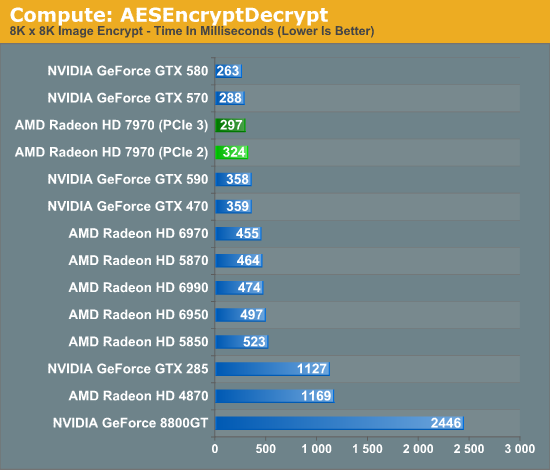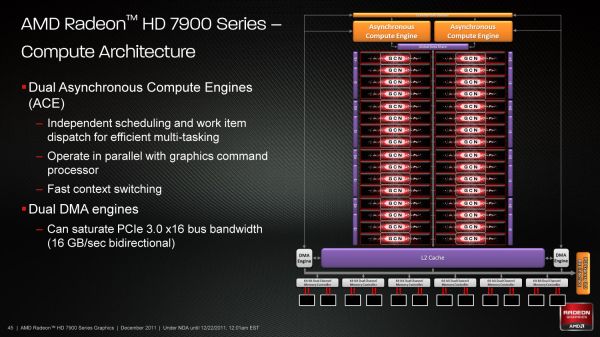AMD Radeon HD 7970 Review: 28nm And Graphics Core Next, Together As One
by Ryan Smith on December 22, 2011 12:00 AM EST- Posted in
- GPUs
- AMD
- Radeon
- ATI
- Radeon HD 7000
PCI Express 3.0: More Bandwidth For Compute
It may seem like it’s still fairly new, but PCI Express 2 is actually a relatively old addition to motherboards and video cards. AMD first added support for it with the Radeon HD 3870 back in 2008 so it’s been nearly 4 years since video cards made the jump. At the same time PCI Express 3.0 has been in the works for some time now and although it hasn’t been 4 years it feels like it has been much longer. PCIe 3.0 motherboards only finally became available last month with the launch of the Sandy Bridge-E platform and now the first PCIe 3.0 video cards are becoming available with Tahiti.
But at first glance it may not seem like PCIe 3.0 is all that important. Additional PCIe bandwidth has proven to be generally unnecessary when it comes to gaming, as single-GPU cards typically only benefit by a couple percent (if at all) when moving from PCIe 2.1 x8 to x16. There will of course come a time where games need more PCIe bandwidth, but right now PCIe 2.1 x16 (8GB/sec) handles the task with room to spare.
So why is PCIe 3.0 important then? It’s not the games, it’s the computing. GPUs have a great deal of internal memory bandwidth (264GB/sec; more with cache) but shuffling data between the GPU and the CPU is a high latency, heavily bottlenecked process that tops out at 8GB/sec under PCIe 2.1. And since GPUs are still specialized devices that excel at parallel code execution, a lot of workloads exist that will need to constantly move data between the GPU and the CPU to maximize parallel and serial code execution. As it stands today GPUs are really only best suited for workloads that involve sending work to the GPU and keeping it there; heterogeneous computing is a luxury there isn’t bandwidth for.
The long term solution of course is to bring the CPU and the GPU together, which is what Fusion does. CPU/GPU bandwidth just in Llano is over 20GB/sec, and latency is greatly reduced due to the CPU and GPU being on the same die. But this doesn’t preclude the fact that AMD also wants to bring some of these same benefits to discrete GPUs, which is where PCI e 3.0 comes in.
With PCIe 3.0 transport bandwidth is again being doubled, from 500MB/sec per lane bidirectional to 1GB/sec per lane bidirectional, which for an x16 device means doubling the available bandwidth from 8GB/sec to 16GB/sec. This is accomplished by increasing the frequency of the underlying bus itself from 5 GT/sec to 8 GT/sec, while decreasing overhead from 20% (8b/10b encoding) to 1% through the use of a highly efficient 128b/130b encoding scheme. Meanwhile latency doesn’t change – it’s largely a product of physics and physical distances – but merely doubling the bandwidth can greatly improve performance for bandwidth-hungry compute applications.
As with any other specialized change like this the benefit is going to heavily depend on the application being used, however AMD is confident that there are applications that will completely saturate PCIe 3.0 (and thensome), and it’s easy to imagine why.
Even among our limited selection compute benchmarks we found something that directly benefitted from PCIe 3.0. AESEncryptDecrypt, a sample application from AMD’s APP SDK, demonstrates AES encryption performance by running it on square image files. Throwing it a large 8K x 8K image not only creates a lot of work for the GPU, but a lot of PCIe traffic too. In our case simply enabling PCIe 3.0 improved performance by 9%, from 324ms down to 297ms.

Ultimately having more bandwidth is not only going to improve compute performance for AMD, but will give the company a critical edge over NVIDIA for the time being. Kepler will no doubt ship with PCIe 3.0, but that’s months down the line. In the meantime users and organizations with high bandwidth compute workloads have Tahiti.











292 Comments
View All Comments
CeriseCogburn - Thursday, March 8, 2012 - link
The gentleman should get one of the high end cards, and run on the common 19x0 x 1xxx monitors that poor people have several of nowadays, then crank up a decent 3d game and get back to us.These cards are not as powerful as the naysayers think - there's a lot of SUCK left in them even in cheap setups, let alone high end everything X2 or X4.
Ph0b0s - Thursday, December 22, 2011 - link
This was one of the most interesting parts of the article. So the only thing that requires new hardware is "Target Independent Rasterization". What does that do, so we know how much we are missing out on from only having Directx 11 hardware.SlyNine - Thursday, December 22, 2011 - link
Second that.Sgt. Stinger - Thursday, December 22, 2011 - link
I would like to call attention to that the reviewer at www.sweclockers.com noticed a full 10° C temperature drop on full load after removing and re-mounting the cards cooler with a quality thermal paste. This is quite significant, and the card should be more quiet after doing this.Chloiber - Thursday, December 22, 2011 - link
Computerbase noticed the exact same thing. They said, that AMD even told them, that there was a problem with the thermal paste (that's why they tested it specifically).It's still as loud as a GTX590 with new thermal paste though... :>
Sgt. Stinger - Thursday, December 22, 2011 - link
Well, yes, unless you can use custom fan profiles. I hope it is possible at least via third party software.If not, the cheapest way to get a reference cooler quiet is to remove the shroud and original fan, and strap on a couple of 120mm fans :D
Ryan Smith - Thursday, December 22, 2011 - link
This is the first I've heard of this. I've pinged AMD, but if they believed it was a problem for us I expect we would have heard about it by now.Sgt. Stinger - Friday, December 23, 2011 - link
Well, maybe, but your load temps seem to correspond to sweclockers load temps as they were before re-mounting the cooler. (here's their temp graph, before: http://www.sweclockers.com/image/diagram/2621?k=3f... ) and after remounting they got 66° C instead.SlyNine - Friday, December 23, 2011 - link
Honestly I'd rather have these benchmarks now than have the benchmarks cut any shorter becuase he had to remount the fan.Worth looking in to moving forward though.
CeriseCogburn - Thursday, March 8, 2012 - link
Oh, so another amd defect in released cards problem... so did we ever get the same treatment for the 480 or the 470 or the 580 or the 570 ?NO !
Of course not silly rabbit, screw nvidia and excuse amd and blame anything and anyone but.....
Thank you this is hilarious...